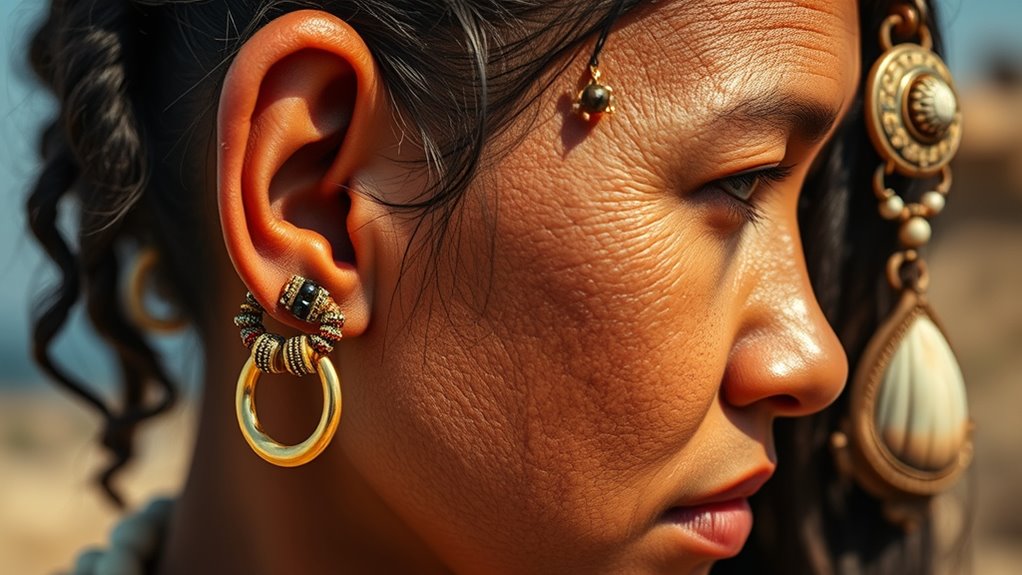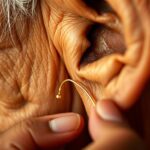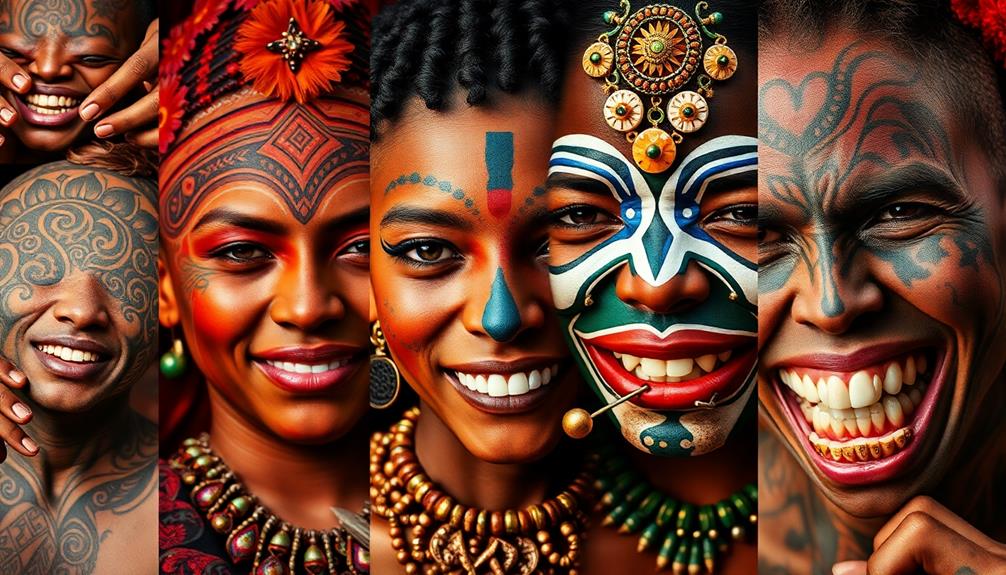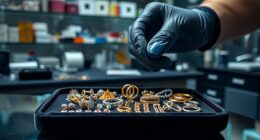Ancient piercing traditions reveal much about cultures from Egypt to the Arctic. In Egypt, piercings marked rites of passage, spiritual devotion, and social status, often intertwined with religious symbolism. African communities used body modifications to signify maturity and beauty, while Arctic tribes like the Inuit incorporated piercings into spiritual rituals honoring spirits and life milestones. These practices built strong cultural bonds and preserved identities. Keep exploring to discover how these ancient customs continue to influence modern body art worldwide.
Key Takeaways
- Ancient piercings symbolized identity, social status, and spiritual beliefs across diverse cultures like Egypt, Africa, and the Arctic.
- Ritual piercing practices often reinforced community bonds and cultural heritage, serving as rites of passage or spiritual devotion.
- Traditional motifs from ancient societies are incorporated into modern jewelry, blending historical symbolism with contemporary fashion.
- Piercings in Arctic communities honored spirits and marked significant life events, reflecting spiritual and environmental ties.
- Modern trends reinterpret ancient piercing symbols, fostering cultural appreciation while maintaining their historical significance.
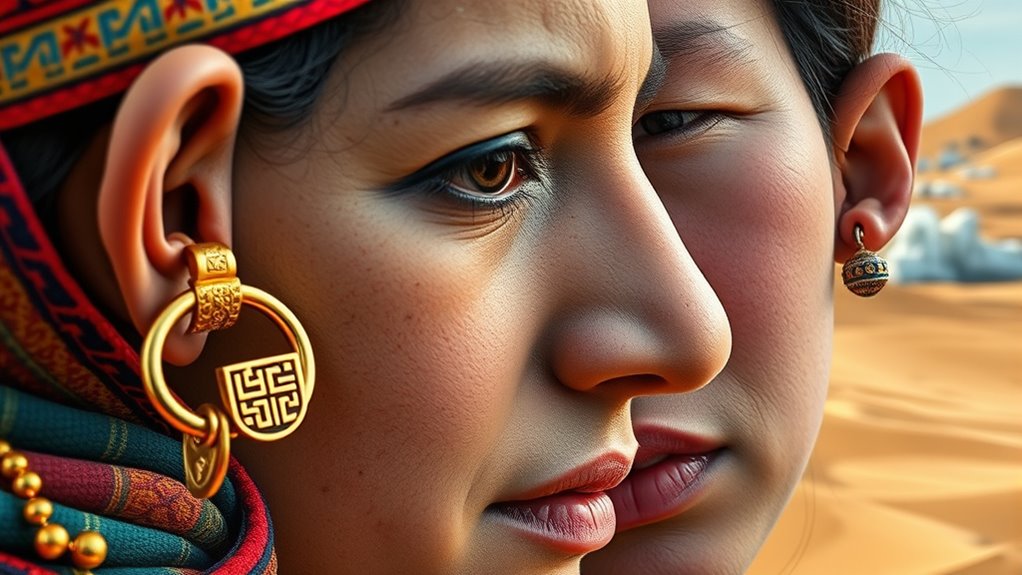
From ancient Egypt to the icy Arctic, piercing traditions have long served as powerful symbols of identity, status, and cultural heritage. These practices weren’t just about adornment—they conveyed social rank, spiritual beliefs, and communal belonging. In Egypt, for instance, piercings often marked rites of passage or religious devotion, with jewelry and body modifications playing crucial roles in spiritual rituals. Piercing traditions carried deep cultural significance, connecting individuals to their ancestors and divine forces. Today, many of these ancient symbols are reinterpreted through modern lenses, blending tradition with contemporary fashion. You might see traditional Egyptian motifs reimagined in jewelry designs or body art that honors ancestral customs while embracing current trends. This ongoing reinterpretation allows people worldwide to appreciate the historical weight of piercings while making them personal and relevant.
As you explore different cultures, you’ll notice that piercing practices are as diverse as the societies themselves. In parts of Africa, elaborate lip plates or stretched earlobes symbolize maturity, beauty, or social status. These modifications are often accompanied by specific rituals that reinforce community bonds and cultural identity. Moving northward, Arctic communities like the Inuit have incorporated piercings into their spiritual and social lives, using body modifications to honor spirits or mark significant life events. These traditions serve as tangible links to the environment, history, and spiritual beliefs. When you consider these practices from a broader perspective, you see how piercings transcend mere aesthetics—they embody a collective memory and social structure. Recognizing the cultural significance behind these practices enriches your understanding of their enduring importance across generations.
Throughout history, cultures have adapted piercings to reflect changing values and influences. In modern times, you might notice how pop culture and fashion trends reinterpret ancient symbolism. For example, traditional nose or lip piercings from Africa and the Middle East have become popular worldwide, often stripped of their original cultural context but still carrying echoes of their roots. Some contemporary artists and jewelry makers incorporate ancient motifs into stylish designs, allowing you to wear history with pride. These modern reinterpretations don’t erase the original meaning but rather transform it, making ancient traditions accessible and meaningful in today’s world. Whether you choose a simple earring inspired by indigenous designs or a more elaborate body modification, understanding the cultural significance behind these practices deepens your appreciation and connection to a global heritage that spans thousands of years.
Frequently Asked Questions
How Did Ancient Cultures Sterilize Piercing Tools?
You might be surprised to learn that ancient cultures used traditional sterilization methods for piercing tools, often relying on fire or boiling to kill germs. These practices reflected their emphasis on cultural hygiene, ensuring tools were as clean as possible before piercing. By heating metal implements in flames or boiling water, they effectively reduced infection risk, demonstrating a sophisticated understanding of maintaining health and safety during their piercing rituals.
Were There Specific Jewelry Materials Used in Ancient Piercings?
Imagine a world where jewelry whispers stories through materials used, and craftsmanship transforms simple elements into sacred symbols. In ancient piercings, materials like gold, silver, bone, and shell took center stage, each chosen for their spiritual or social significance. Skilled artisans crafted these pieces with care, turning raw materials into meaningful jewelry that marked rites of passage, status, or protection, making every piercing a work of art etched into history.
What Rituals Accompanied Piercings in Different Ancient Societies?
You’ll find that in many ancient societies, piercings came with rituals that held spiritual significance and conveyed societal status. You might participate in ceremonies where elders bless the piercing, symbolizing protection or divine favor. Some cultures see piercings as rites of passage, marking your progression into adulthood or high social standing. These rituals reinforce community bonds and honor spiritual beliefs, making piercings far more than mere ornamentation.
How Did Ancient Piercings Influence Modern Body Modification Trends?
Ancient piercings influence modern body modification trends by shaping their cultural significance and aesthetic evolution. You see, today’s body art often echoes traditional symbols of status, spirituality, or identity from ancient societies. As you get pierced, you’re part of a long history that values self-expression and cultural heritage. These historical roots make modern trends more meaningful, blending past symbolism with contemporary styles, enriching your personal and cultural identity.
Are There Documented Health Risks From Ancient Piercing Practices?
You should know that ancient piercing practices did carry documented health risks, especially infection risks due to limited sterile techniques. Many cultures had unique health practices to minimize these dangers, but some infections still occurred. These risks highlight the importance of proper hygiene and safety in modern body modifications. While ancient piercers aimed to honor cultural traditions, today’s standards help prevent health issues linked to body piercing.
Conclusion
As you imagine these ancient traditions, picture yourself with a piercing that connects you to centuries of history, like an Egyptian scarab or Arctic bead. Some believe these adornments protected wearers from spirits or marked essential life stages. While the exact origins may be debated, the power of these piercings lies in their ability to tie you to a shared human story—one of identity, belief, and enduring cultural beauty across time and space.

